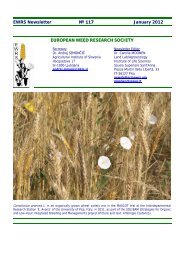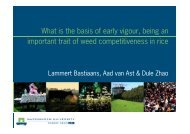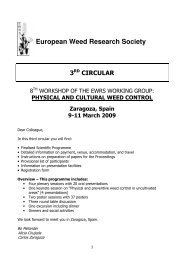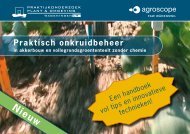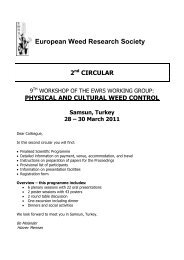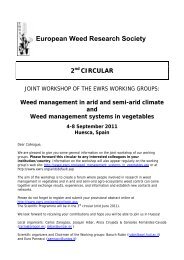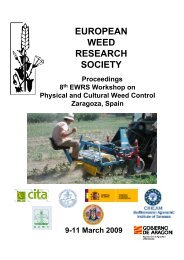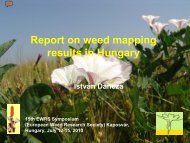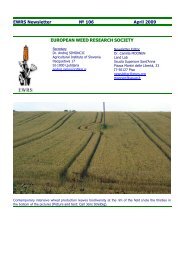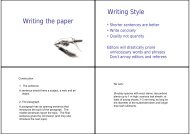Physical and Cultural Weed Control Working Group of - European ...
Physical and Cultural Weed Control Working Group of - European ...
Physical and Cultural Weed Control Working Group of - European ...
Create successful ePaper yourself
Turn your PDF publications into a flip-book with our unique Google optimized e-Paper software.
9 th EWRS Workshop on <strong>Physical</strong> <strong>and</strong> <strong>Cultural</strong> <strong>Weed</strong> <strong>Control</strong> 86<br />
Samsun, Turkey, 28 – 30 March 2011<br />
Integrating preventive <strong>and</strong> curative non-chemical weed control strategies on<br />
concrete block pavements<br />
B. De Cauwer 1 , M. Fagot 1 , D. Reheul 1 , R. Bulcke 1 , E. Boonen 2 <strong>and</strong> A. Beeldens 2<br />
1 Ghent University, Faculty <strong>of</strong> Bioscience Engineering, Department <strong>of</strong> Plant Production, Coupure<br />
Links 653, B-9000 Ghent, Belgium Email Benny.DeCauwer@UGent.be<br />
2 Belgian Road Research Centre, Fokkersdreef 21, B-1933 Sterrebeek , Belgium<br />
The recent phase out <strong>of</strong> herbicidal use on public pavements by the Flemish government triggers<br />
the development <strong>of</strong> new alternative weed control strategies. In this study frequency <strong>of</strong> weed control<br />
required to maintain a minimum picture quality <strong>of</strong> the pavement was determined for six different<br />
non-chemical weed control scenarios <strong>and</strong> four different block pavings.<br />
In September 2009, a strip plot experiment was established in Sterrebeek comprising four<br />
different block pavings (vertical plots) <strong>and</strong> six different curative weed control scenarios (horizontal<br />
plots) in four blocks. Size <strong>of</strong> intersection plots was 1.6 m by 7.5 m. Block paving types included<br />
concrete block paving with drainage holes, concrete block paving with enlarged joints, porous<br />
concrete block paving <strong>and</strong> conventional (not permeable) block paving. Joints were filled with<br />
organically polluted (by adding 20% fine compost by volume) s<strong>and</strong> <strong>of</strong> Lustin for the porous <strong>and</strong><br />
conventional pavings <strong>and</strong> organically polluted crushed porphyry for the pavings with drainage holes<br />
<strong>and</strong> enlarged joints. Before filling the joints, filling materials were contaminated with a seed<br />
mixture containing seven dominant, hard to control weed species (Taraxacum <strong>of</strong>ficinale, Poa<br />
annua, Plantago major, Trifolium repens, Cerastium fontanum, Sagina procumbens <strong>and</strong> Conyza<br />
canadensis). Polluted joint fillers were used to simulate in situ organic pollution <strong>of</strong> joints over time.<br />
Curative weed control scenarios comprised four scenarios with repeated use <strong>of</strong> one single weed<br />
control method (brushing, flaming, application <strong>of</strong> hot air <strong>and</strong> selective application <strong>of</strong> hot water) <strong>and</strong><br />
two scenarios with alternating use <strong>of</strong> brushes <strong>and</strong> hot air technique (scenarios differ in time interval<br />
between brushing <strong>and</strong> hot air application). The energy dose applied by the weed control equipment<br />
was regulated by the driving speed <strong>and</strong> corresponded to the dose required to achieve a 80%<br />
reduction in weed coverage (ED80 value). Treatments were repeated each time weed coverage<br />
exceeded a predefined maximum weed coverage percentage. During the growing season <strong>of</strong> 2010,<br />
weed coverage (%) <strong>and</strong> weed composition were periodically recorded in 6 fixed quadrats per plot<br />
by using Image J s<strong>of</strong>tware. Treatment frequency obtained in this study was defined as the number <strong>of</strong><br />
treatments required to guarantee a minimum picture quality <strong>of</strong> the paving during the growing<br />
season.<br />
Treatment frequency was highest for pavings with drainage holes <strong>and</strong> enlarged joints (between<br />
3-5) <strong>and</strong> lowest for porous pavings (between 1-2), irrespective <strong>of</strong> the weed control scenario. Lowest<br />
frequency (1-3) was recorded for hot water technique, irrespective <strong>of</strong> paving type. Frequencies <strong>of</strong><br />
scenarios with hot air technique <strong>and</strong> flaming were similar (3-5).Compared to repeated use <strong>of</strong> a<br />
single weed control technique, alternating weed control techniques did not yet result in a reduction<br />
<strong>of</strong> treatment frequency. Due to the observed species-specific sensitivity to thermal weed control<br />
techniques, shifts in weed composition occurred in plots treated repeatedly with the same technique.<br />
Overall, these results show an opportunity for integrating weed prevention strategies (using suitable<br />
paving materials) <strong>and</strong> curative strategies (using effective weed control techniques) to lower adverse<br />
environmental impact <strong>of</strong> weed control by reducing its frequency required to maintain weed<br />
coverage to an acceptable level.



